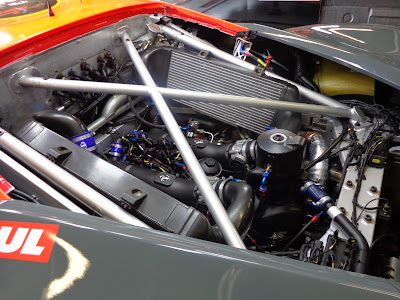With the 24h of Le Mans right around the corner, most of the attention is focused on the top hybrid class of LMP1-H. While the cars are amazing, as shown in Racecar Engineering Magazine, I wanted to delve deeper into the stuff of the GTE Pro class. With the likes of Ford, Ferrari and Porsche in one class, it makes for one of the most competitive classes of racing, while having a big blend of technology and engineering being used, which I love!
A quick run down of the car in the class thus follows: Ford, Corvette, Ferrari, Porsche and Aston Martin. Albeit, I have less information on the C7.R Corvette, as they only race at Le Mans. In 2017, so leaving that one out. I was at Silverstone WEC this year, so I was able to chat to some of the guys and gals in the teams about their race cars.
 |
| Pic: Stefan Ruitenberg |
Starting off with Ford, who were the overall class winners at Le Mans in 2016, which marked the first year of the GT race programme, albeit it a controversy race car. The GT is a very interesting car in my eyes both aerodynamically and mechanically. It's fundamentally known that a tear-drop shape is best aerodynamically, and this is what Ford have applied to the upper surface of the bodywork.
To package the engine, suspension and cooling at the back of the car, Ford has had to apply structures which taper of the tear-drop and onto the rear wheel wells, which house mini intercoolers. I like this idea, as Ford are able to to get the best overall aero profile, while still packaging everything else.
At the front end, shown above, I was able to get a good look at the cooling the front suspension. The slanted positioning of the radiators means Ford can get the best profile to suit the aerodynamics. The suspension remains fairly standard to this GT car, with double wishbones all-round which are actuated by pushrods.
 |
| Pic: Stefan Ruitenberg |
The new 2017 911 RSR is a completely new development with all-new: suspension, body, aerodynamics, engine and transmission to name a few, have all been designed from the ground up for its new racer. With the engine, the company has improved downforce by the bigger and higher diffuser. On the previous RSR, the rear mounted engine was mounted lower for better C of G, this thus gave the car a small diffuser, and a compromise in the aerodynamics. This has now all be addressed with the engine being mounted in the middle of the car, as seen in the Ferrari 488 and Ford GT.
I really like this neat overhaul, It not only makes the 911 more dynamic and stable, it helps with the flow structure underneath the car, with a higher angle of attack of the diffuser. The car also uses pushrod suspension all round with four-way adjustable damper with dual coil-over springs.
 |
| Pic: Stefan Ruitenberg |
Aston Martin
I feel as though the Aston Martin is underestimated in GTE class. But for 2017, the team has updated the car further, as well as remaining quite interesting in my eyes. For instance, the rear plenum that lies in the boot, shown above, is a way of passing flow to a radiator.
Aston Martin even confirmed to me that this improves the aerodynamics here. Above the diffuser, the car has a large radiator, which is fed flow via the plenum and the ducts mounted at the back of the car. Aston Martin is able to pass air through the diffuser, thus seeking a performance gain by the diffuser.
I also spotted the front suspension and brakes on show at Silverstone. With pushrod being used with double upper and lower wishbones. Of which are made from steel.
I also spotted the front suspension and brakes on show at Silverstone. With pushrod being used with double upper and lower wishbones. Of which are made from steel.
 |
| Pic: Stefan Ruitenberg |
Ferrari
The 488 GTE contested the WEC for the first team last year, after a very successful life in the 458. The car very almost won Le Mans in 2016, coming in 2nd place in GTE Pro, thus spoiling Ford's Le Mans return.
The 488 is a simple yet effective race car, which much emphasis occurring at the back of the car. The car has a mid-mounted 4.5L V8 with twin coolers mounted above it. I got a good image of the packaging this year at Silverstone, which is shown above.
The positioning of the coolers means the side pods can be slimmed to increase flow efficiency. This space has been replaced by ducts that feed gearbox and oil coolers mounted at the rear.
Conclusion
Once the finally BoP (Balance of Performance) has been issued by the ACO/FIA, we will for sure have a clearer picture of where the cars stand among the GTE Pro field. This BoP is going of 2016 race pace, but this was later changed, where the FIA and ACO will collect data from the Le Mans test day and qualifying ahead of the big race. Let me know what you think.
I hope you enjoy the race!
No comments:
Post a Comment